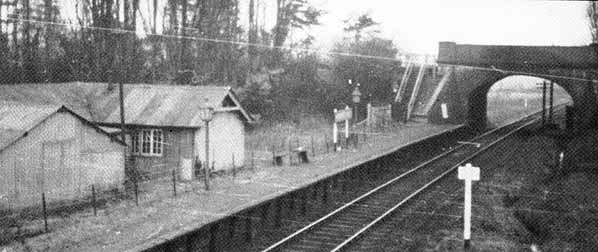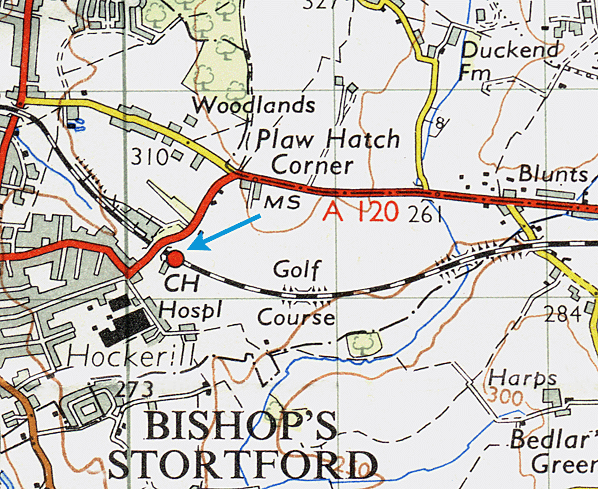|
Notes: By 1860 most of the rail network was in place, leaving
only the gaps between main line stations to be filled. Central
and West Essex, a predominantly rural area, had been largely ignored
during the initial development because it wasn't considered a
viable proposition.
In 1859 an unexpected proposal was submitted to Eastern Counties
Railway by a group of Hertfordshire businessmen who were anxious
to obtain easy transport for malt and barley from towns and villages
in West Essex.
Their proposal was for a railway line, 18 miles long, linking
the towns of Bishop's Stortford, Dunmow and Braintree. They readily
agreed to the proposal, offering to have the route surveyed and
donating £40,000 to help with construction. The application
was put to parliament and permission was given for the branch
line to go ahead.
In 1862 the ECR was amalgamated with the Great Eastern Railway
(GER) but directors were adamant they would continue with the
branch line. Despite poor local backing and the shortfall in subscriptions,
the GER decided to fully finance the line themselves and absorb
all of the shares of the local company.
 The first turf was ceremonially cut at Dunmow on the 24 February
1864 and contractors began work the following. Virtually the entire
length of the branch line's 18 mile route was single track, except
at Dunmow and one or two other stations where dual track allowed
trains to pass each other. The line was finally opened for passenger
use on 22 February 1869 with intermediate stations at Takeley,
Felstead & Rayne. Further stations were later added, Easton
Lodge in 1894, Hockrill Halt in 1910 and Stane Street and Banister
Green Halts in 1922. The first turf was ceremonially cut at Dunmow on the 24 February
1864 and contractors began work the following. Virtually the entire
length of the branch line's 18 mile route was single track, except
at Dunmow and one or two other stations where dual track allowed
trains to pass each other. The line was finally opened for passenger
use on 22 February 1869 with intermediate stations at Takeley,
Felstead & Rayne. Further stations were later added, Easton
Lodge in 1894, Hockrill Halt in 1910 and Stane Street and Banister
Green Halts in 1922.
With hindsight, it is now apparent that the branch line was never
going to succeed as a profit making passenger service. The branch
line's saviour came in the 1880s. The sudden demand for agricultural
produce in London combined with new industries that were starting
up in Braintree, both required a freight service and it was this
that was to provide important revenue for the railway. Freight
traffic continued to grow, especially at the Braintree end of
the line, but by the end of the 19th century passenger traffic
to Bishop's Stortford remained light.
When the GER finally amalgamated with the London & North
Eastern Railway (LNER) on 1 January 1923, the new company made
every effort to increase passenger traffic on the branch line
by doubling the initial three passenger trains a day running in
each direction, to six. But all to no avail. It was still the
carriage of freight that supplied the revenue.
During the Second World War the line was used to transport thousands
of tons of rubble for the construction of Saling airfield, 5 miles
from Braintree and, later, when it became operational, massive
loads of bombs were carried to the same destination under cover
of darkness. The United States Air Force bases at Stansted and
Easton Lodge were also regularly supplied with armaments and stores
arriving via Bishop's Stortford and Takeley station. After the
invasion of Europe in June 1944 the line was used by ambulance
trains to bring back wounded soldiers.
After the war the public's use of motor cars and competition
from bus transport increased, the passenger service between Bishop's
Stortford and Braintree ran virtually empty and inevitably, closure
of the line for passenger traffic was announced. Despite public
protests, the last train to run between the two towns was on 1
March 1952.

Despite the loss of the passenger service after 83 years the
line was kept open for freight traffic, which was still an important
source of revenue. But by 1968 more and more freight was being
transported by road and the branch line now became uneconomical
to keep open.
By the end of 1971 all freight traffic had ceased, and on 27
July 1972 a final enthusiast's trip ran from Bishop's Stortford
to Easton Lodge and back. By the autumn of that year most of the
track had been taken up, apart from the last mile out of Bishop's
Stortford. British Rail were considering the possible role this
section of line might play in carrying additional traffic to a
growing Stansted Airport, but proposals came to nothing and in
1974 the remaining track was removed.
Much of the old track bed now forms the Flitch
Way a walking and cycling path from Braintree to Bishops Stortford
along the 15 mile course of the Bishops Stortford, Dunmow &
Braintree Railway line
HOCKERILL HALT
Hockerill Halt was opened in 1910 for Bishops Stortford Gold Club
but was available to the public as well. Initially passengers
traveling from Dunmow direction had to buy a ticket to Bishops
Stortford but when two other halts were opened in 1922 tickets
to the halt were issued by the guard. The Halt was sited on the
up side of the line and comprised and earth and clinker platform
with timber facing.
Ticket from Michael Stewart, route map drawn by Alan Young
Sources:
Other web sites: Railways
of Essex & Branching
Out
To see the other
stations on the Bishops Stortford - Braintree branch click on
the station name: Stane
Street Halt, Takeley,
Easton Lodge, Dunmow,
Felsted, Bannister
Green Halt & Rayne
|



 Home Page
Home Page 


 Home Page
Home Page